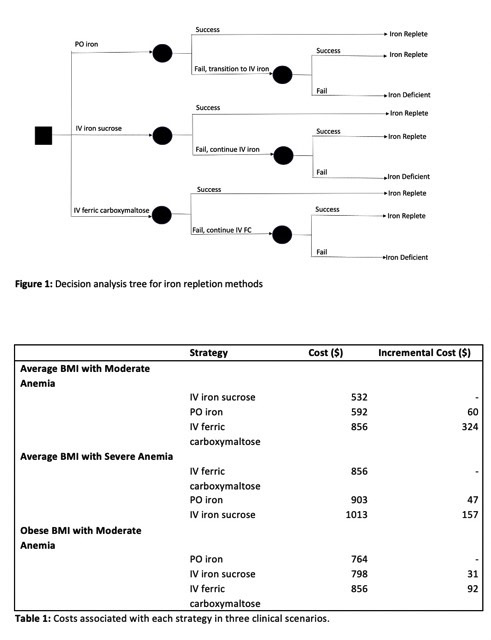Background: Iron deficiency anemia is common in adolescent females. Treatment is possible with either enteral (PO) or intravenous (IV) formulations. The cost-effectiveness of each method is unknown. In addition, treatment cost-effectiveness likely differs between three distinct adolescent female subgroups with iron deficiency: average BMI with moderate anemia, average BMI with severe anemia, and obese BMI with moderate anemia.
Methods: A decision analysis model evaluated PO ferrous sulfate, IV iron sucrose, and IV ferric carboxymaltose use in adolescent female subgroups, comparing costs associated with each treatment strategy from a healthcare perspective. In the PO iron strategy, initial PO therapy failure prompted conversion to IV iron sucrose use. Literature review was performed to obtain model parameters. The effectiveness term in the model was the likelihood of successful iron repletion, which was assumed to be identical for each strategy in the base case analysis. Model time horizon was three months. One-way sensitivity analyses evaluated model uncertainty.
Results: In moderate anemia and average BMI, IV iron sucrose was least costly at $531.79 (compared to $592.12 for PO iron and $855.78 for IV ferric carboxymaltose). Varying the PO iron success likelihood and clinic visit frequency could favor the PO iron strategy. With severe anemia and average BMI, IV ferric carboxymaltose was least costly at $855.78 (vs. $1013.44 for IV iron sucrose and $902.78 for PO iron). Variation in infusions needed for IV iron sucrose (and therefore anemia severity) alters the preferred strategy, with IV iron sucrose favored if 1-4 infusions are required, PO iron favored if 5-6 infusions required, and IV ferric carboxymaltose preferred if 7 or more infusions are needed. In the moderately anemic obese group, PO iron was preferred, costing $763.90 compared to $798.12 for IV iron sucrose and $855.78 for IV ferric carboxymaltose. In a one-way sensitivity analysis, PO iron was favored at a weight >74kg (base case value 90); below this weight, IV iron sucrose was preferred.
Conclusion: The cost-effectiveness of different iron repletion strategies depends on the adolescent female subgroup affected. Patient weight and anemia severity are important clinical characteristics to consider when assessing which method is the most cost-effective.
Disclosures
Smith:Nico Corporation: Research Funding; Sanofi Pasteur: Research Funding.


This feature is available to Subscribers Only
Sign In or Create an Account Close Modal